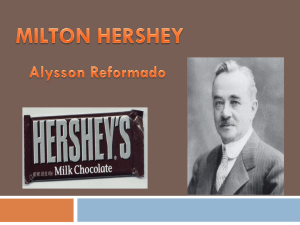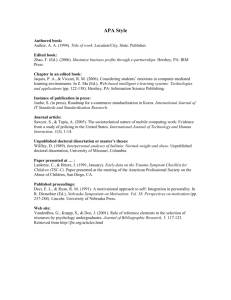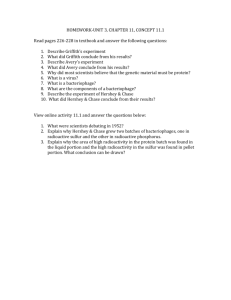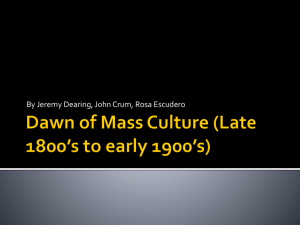The Hershey Company (HSY)
advertisement
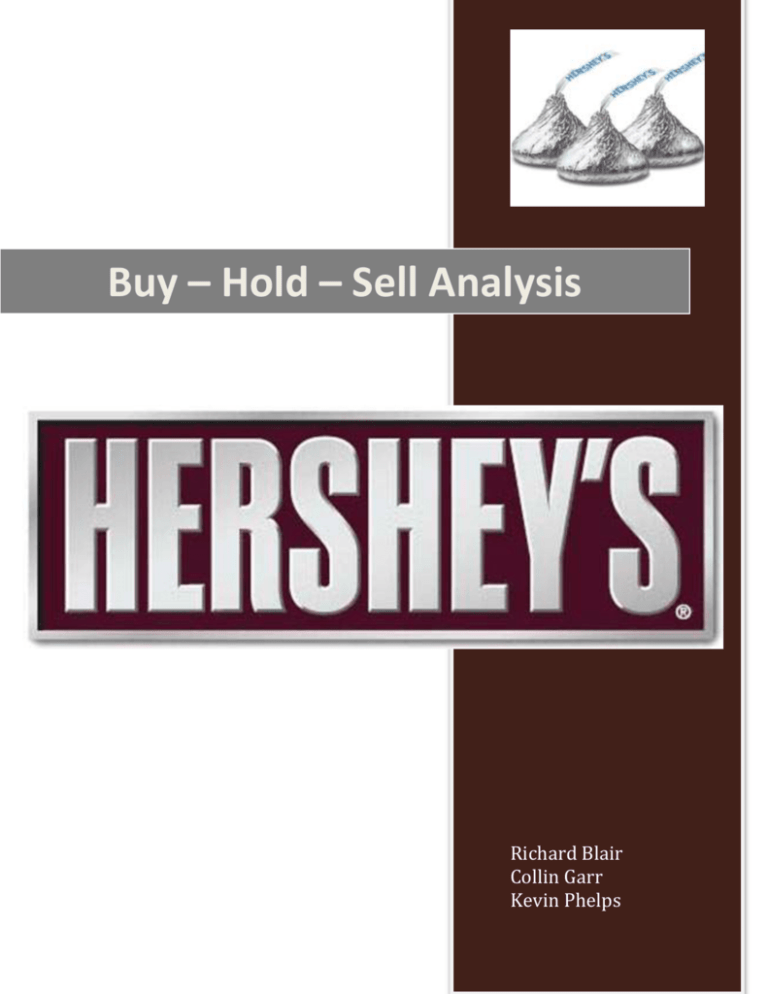
Buy – Hold – Sell Analysis Richard Blair Collin Garr Kevin Phelps TABLE OF CONTENTS Business Overview 3 The Hershey Company Industry Overview 5 Financial Statements 7 Income Statement Balance Sheet Statement of Cash Flows Ratio Analysis 11 Liquidity and Efficiency Ratios Profitability Ratios Long-Term Solvency Ratios Cash Flow Adequacy Ratios Hershey vs. Nestlé: A Comparative view Analsysis Overview Buy, Hold, or Sell? The Hershey Company Buy-Hold-Sell Analysis 19 Bibliography The Hershey Company Buy-Hold-Sell Analysis 20 Business Overview Milton S. Hershey founded The Hershey Company in 1894. At the time of its founding, Hershey’s was considered a subsidiary of the Lancaster Caramel Company. Since its founding, The Hershey Company has expanded its product market to approximately 60 countries globally, employing 14,800 people in the process. An entire “Hershey Empire” has been created in the process with the growth of Hershey, Pennsylvania growing exponentially with the company, as well as Hershey Park (an amusement park) and a “Hershey Brand” that is globally recognized. Hershey’s current president and CEO is John P. Bilbrey. Bilbrey has had extensive corporate experience, considering he has spent 20+ years with Proctor & Gamble. He has had quite a bit of experience with international business, which has proven to be rather beneficial to Hershey’s considering its rapid international growth. The company benefits from the centralization of the The Hershey Company Buy-Hold-Sell Analysis Hershey’s President & CEO John P. Bilbrey 4 ISIC (International Standard Industrial Classification) 1543. As of 2013, Hershey had $7.146 billion in revenue that can largely be explained by Hershey’s focus on the American market before its international markets. Since America is typically a great importer of chocolate, Hershey has a very large and loyal national consumer base with which it preoccupies itself. Looking at a graph of long-term fluctuations in the market price of Hershey stock (HSY), one can ostensibly notice the reliance of the company on consumer spending, as it suffers from its most major contractions during periods of economic recession. The most recent economic developments seem to hint at steadier market prices for Hershey in the immediate future. The Hershey Company Ticker – HSY Price (as of 4/2/14) – 102.31 52-Week High – 108.84 52-Week Low – 84.84 MKT Cap – 23.1B Shares – 223.81M The Hershey Company Buy-Hold-Sell Analysis 5 The Hershey Company Buy-Hold-Sell Analysis 6 Industry Overview The Hershey Company (HSY) falls under the Consumer Goods sector of the economy. Consumer Goods, sometimes abbreviated as FMCG, accounts for nearly 25% of the total share of spending in the economy by sector. This large market share allows huge amounts of derivation within the market. Hershey is specifically a member of the Confectioners branch of the FMCG, specifically the ISIC 1543. This third tier classification simply categorizes Hershey as a sugar and chocolate manufacturer. As of 2012, this particular industry was worth approximately $35.9 billion. The ISIC 1543 itself is rather centralized, with the largest few companies controlling the majority of the net worth. Moving forward, it is imperative to recognize a several factors in the practicality of this particular market. FMCG as a sector is heavily dependent The Hershey Company Buy-Hold-Sell Analysis 7 upon consumer spending and is heavily affected by cyclical economic shocks; thus, current market data may be suffering as a result of the prolonged effects of the Great Recession. Despite this economic phenomenon, the ISIC 1543 can look forward to large projected growth in the industry as a result of emerging markets. Currently, Europeans consume the largest amount of chocolate, 17 pounds per capita, and Americans aren’t far behind, consuming more than 11 pounds. However, where the market may see tremendous growth is in Indian and other Asian markets. From 2013-2018, the annual growth rate of the Indian chocolate market alone is estimated to hit 21%. * It is also worth noting the reliance of the ISIC 1543, and all chocolateproducing corporations, on the cocoa bean. As emerging markets develop, a The Hershey Company Buy-Hold-Sell Analysis 8 taste for chocolate products will cause a scarcity of the bean itself and in turn, prices will rise. Raw material costs of producing a generic chocolate bar have risen an astounding 28% within the last 20 months, and the cost of cocoa butter itself has risen nearly 63%. Long-term weather changes, as well sociopolitical and economic tensions in Africa (a major bean producer), may continue to result in even higher costs. The Hershey Company Buy-Hold-Sell Analysis 9 Financial Statements Income Statement (In Millions of $) Gross Profit Income from Operations Net Earnings 2012 2011 2010 2,859.9 2,548.9 3,255.8 1,111,148 1,055,028 4,765,711 660,931 628,962 509,799 The Hershey Company’s gross profit has increased each year since 2010 because the company has maintained its production of Hershey staples such as Hershey Bars and Hershey Kisses while developing new products such has Reese’s Pieces and Jolly Ranchers. The Hershey Company focuses on retaining its entrepreneurial attitude and strongly values innovation. The Hershey Company Buy-Hold-Sell Analysis 10 Hershey’s income from operations was up 1% in 2012 compared to 2011. This is not necessarily surprising given the slow growth of the economy, as well as Hershey’s recent investments in new factories and factory equipment, which may take several years to become profitable. Over the past few years, Hershey’s income from operations has risen, so an inconsequential increase is not worrisome as of now, but Hershey executives and investors should certainly be wary. Hershey’s net earnings increased in 2012 in comparison to 2011 in part because of the expansion of the Hershey brand. Hershey had previously relied solely on its North American market but increases in foreign sales demonstrate Hershey’s success thus far internationally and the Company’s ability to further expand in Asia and Europe. The Hershey Company Buy-Hold-Sell Analysis 11 *When conducting this financial analysis, The Hershey Company’s Annual Report to Stockholders/Form 10-K had not been released for the years 2013 and 2014. Balance Sheet (2012) (In Millions of $) Assets = Stockholder’s Equity + Liabilities 4,754,839 = 1,048,373 + 3,706,466 (2011) (In Millions of $) Assets = Stockholder’s Equity + Liabilities 4,407,094 = 880,943 + 3,526,151 The Hershey Company Buy-Hold-Sell Analysis 12 Statement of Cash Flows (In Millions of $) Gross Profit 2012 2011 2010 2,859.9 2,548.9 3,255.8 1,111,148 1,055,028 4,765,711 660,931 628,962 509,799 Income from Operations Net Earnings Hershey is currently in the process of financing a moderate amount of its growth with debt as a result of the expenditures needed to expand. Hershey has developed new machinery and updated old machinery that makes its products more efficiently which yields a better overall product. Income from operations is much lower than that in 2010, which may be a symptom of this expansion, but this decrease is still a concern for Hershey executives and investors. Alternatively, net earnings have increased, which The Hershey Company Buy-Hold-Sell Analysis 13 could point to increased efficiency or lower costs in the manufacturing process. Though Hershey has a lower amount of income from operations and a lower amount of Gross Profit (comparing to 2010), its high net earnings still allows the company to yield relatively high dividends, a total of $1.81 in 2013. This growth is encouraging especially since Hershey’s dividend returns have progressively increased in recent years. These factors demonstrate that Hershey is a strong company, yet Hershey should be cautious of a drastic negative turnaround if markets are not favorable. The Hershey Company Buy-Hold-Sell Analysis 14 Ratio Analysis Liquidity and Efficiency Ratios Ratio Formula Current Current assets Ratio Current Liabilities Acid-test Cash+Short-Term Investments+Current Receivables ratio 2011 2012 2013 1.76 1.44 1.77 0.93 0.81 1.13 15.40 15.44 15.22 6.00 5.90 5.98 Current Liabilities Accounts Net sales Receivable Average Accounts Receivable, net Turnover Inventory Turnover Cost of Goods Sold Average Inventory The Hershey Company Buy-Hold-Sell Analysis 15 Days’ sales uncollected Average Receivables, net X 365 23.70 23.65 23.99 60.81 61.83 61.04 1.40 1.45 1.41 Net sales Days’ sales Ending Inventory in X 365 Cost of Goods Sold inventory Total asset turnover Net sales Average Total Assets Hershey’s liquidity and efficiency ratios demonstrate that Hershey is in a decent position of liquidity. The current and acid test ratios are relatively low but have remained fairly steady with the exception of a minor decrease in 2012; however, the acid-test ratios are much lower than the current ratios. This is not concerning though because much of Hershey’s assets lie in inventory, which is ideal for a company that is a confectioner. The Hershey Company Buy-Hold-Sell Analysis 16 Hershey’s accounts receivable turnover and inventory turnovers are impressive, as well. Over the three-year span observed, the company has collected its receivables and converted them to cash in excess of 15 times a year, on average. Meanwhile, inventory turnover has hovered at or slightly below 6 between the years 2011-2013. Given the massive candy inventory that Hershey maintains, this is not altogether surprising. Days’ sales uncollected and days’ sales in inventory are related to Hershey’s accounts receivable and inventory turnovers, but its statistics surface in a different manner. Hershey collected its receivables between 23.65 and 23.99 days over the past three-years, while Hershey turns over its inventory once every 60.8161.83 days during the same three-years. Total asset turnover is a means that represents a company’s efficiency, demonstrating how well a company uses its assets to generate sales; Hershey’s total asset turnover fluctuated between The Hershey Company Buy-Hold-Sell Analysis 17 1.40 and 1.45, which is representative of it’s sector since Hershey has a smaller base of assets but high sales volume. The ratios discussed represent Hershey’s overall consistency as a company and its emphasis on maintaining it’s inventory healthily to generate revenue and increase total assets. Profitability Ratios Ratio Profit margin ratio Gross margin ratio Return on total assets Return on Formula 2012 2013 10.34 9.95 11.47 41.64 43.04 45.91 14.48 14.42 16.23 71.83 70.10 62.12 Net income Net sales Net Sales - Cost of Goods Sold Net Sales Net income Average Total Assets Net income - Preferred Dividends common stockholders’ 2011 Average common stockholders’ equity The Hershey Company Buy-Hold-Sell Analysis 18 equity Book value per common share Basic earnings per share Shareholders’ Equity applicable to Common Shares 3.81 4.63 7.17 2.74 2.90 3.61 Number of Common Shares Outstanding Net income - Preferred Dividends Weighted-Average Common Shares Outstanding These figures show that Hershey has experienced profitability over the last three-years. Similarly to Hershey’s liquidity ratios, the company’s profits slightly declined in 2012, but in general Hershey’s profitability ratios in 2013 are much stronger than those in the preceding two years. The profit margin and gross margin ratios increased significantly between 2011 and 2013, from 10.34 to 11.47 and 41.64 to 45.91, respectively. Increases in profit margin reflect an improvement in Hershey’s ability to retain income from its sales. Hershey’s gross margin increase shows that the The Hershey Company Buy-Hold-Sell Analysis 19 company is generating more revenue from its sales. Hershey’s progress with its return on assets ratio has grown, as well. From 14.48 in 2011 to 16.23 in 2013, Hershey’s management surely improved its decision-making in employment of assets to maximize profit. Return on stockholders’ equity, book value per common share, and basic earnings per share are more equity-focused but contribute to a company’s profitability. Arguably, the most important of said ratios is return on stockholders’ equity, which represents Hershey’s ability to take its stockholders’ equity and convert it into net income. Here, a weakness from Hershey’s profitability ratios can be recognized as the company’s return on stockholders’ equity has declined for each of the past three-years, falling from 71.83 (2011) to 70.10 (2012), and finally sizeable decrease to 62.12 (2013). However, the rise in book value per common share is attractive to both The Hershey Company Buy-Hold-Sell Analysis 20 Hershey’s executives and stockholders because it shows the valuation of the company’s shares has increased over the three-year period, nearly doubling from 2011 (3.81) to 2013 (7.17). Basic earnings per share estimate the net income that can be assigned to each share of stock. Once again, we see a three-year increase in this ratio, a positive sign for Hershey as the company moves into the future. Long-Term Solvency Ratios Hershey’s current Debt to Equity ratio is 1.22. This ratio falls in a modest range of debt to equity ratios and would signify a moderate amount of growth, which is financed by debt. These results are logical, given the reliance of machinery in the process of creating chocolate. This dependence upon debt to finance growth has increased in recent years, ranging from 2.3 to 1.8 The Hershey Company Buy-Hold-Sell Analysis 21 throughout the year 2012. These developments can be attributed to a $300 million dollar upgrade to one of its major plants, as well as the company’s investment in the globalization of the Hershey brand since the company must globally compete with other significant companies in the consumers goods sector of the stock market such as Nestlé and Mars. Overall, Hershey’s debt to equity ratio is encouraging, as it shows a rather steady rate of growth of both equity and loans that contribute to the general growth of The Hershey Company. Current data for Hershey’s Debt to Asset ratio leads to a measure of approximately 36.62%. This is a relatively safe measure, as it signifies a moderately low amount of financial risk involved in the company’s workings considering the amount of debt it has accrued with regard to its total asset value. Assets would include the machinery needed to produce its many The Hershey Company Buy-Hold-Sell Analysis 22 chocolate products, as well as the land and factories that Hershey owns. It appears as though Hershey falls a bit short in comparison to Nestlé, an industry/sector rival, whose current D/A ratio is about 18.05%, which could potentially signify one of two consequences. First, Nestle may have less debt that Hershey, and given a D/E of about .35, it is very possible that this assumption is accurate. Second, Nestlé may posses more assets than Hershey. Considering the size of Nestlé relative to Hershey and a total asset value around $100 billion compared to about $6 billion, this hypothesis may be accurate as well. Currently, Hershey has an Interest Coverage Ration of about 17.44%. This about falls just short of Nestlé’s coverage ratio of about 23.48% circa 2011-2012. Hershey could pay off about 17.44% of accrued interest with its earnings before interest and taxes (EBIT), which is an acceptable course of The Hershey Company Buy-Hold-Sell Analysis 23 action. Hershey would prefer that this ratio be higher and could be achieved through greater earnings or by cutting of debt-based growth and expensive loans to benefit both the company’s short and long-run growth. Cash Flow Adequacy Ratios Ratio Formula Free Free cash flow per share X (% change from previous cash year) 2011 2012 2013 -66.67 250.13 2.53 -35.56 88.48 8.55 flow ratio percen Market Price per share tage growt h Operat ing Operating Cash Flow X (% change from previous year) cash flow Net Sales ratio percen The Hershey Company Buy-Hold-Sell Analysis 24 tage growt h After an unfavorable year in terms of cash flow ratios in 2011, Hershey was able to make a very strong recovery in 2012 and remain steady in 2013. The free cash flow ratio is a good indicator of whether a company is profitable and it represents the residual money after the company’s investment in capital. Hershey’s free cash flow ratio more than quadrupled in 2012. Operating cash flow, on the other hand, demonstrates nearly the opposite effect. Operating cash flow is the cash that a company possesses before making investments in its operations. This ratio nearly doubled in Hershey’s booming year that was 2012. Having impressive figures in cash flow The Hershey Company Buy-Hold-Sell Analysis 25 ratios speaks to Hershey’s deft management of its cash before, during, and after operations. Hershey vs. Nestlé: A Comparative view Before comparing both Hershey’s and Nestlé, we must first understand the differences between the two. While Hershey and Nestlé produce many similar products, Nestlé has a much wider base of products besides candy including items from baby formula to bottled water. Thus, there may be some rather distinct differences between the Hershey and Nestlé. 2011-2012 Hershey Nestlé Current Ratio 1.77 .91 Inventory Turnover 5.98 5.6 Profit Margin 11.47% 32.6% Return on Equity 66.24% 16.47% 1.22 .339 Debt/Equity The Hershey Company Buy-Hold-Sell Analysis 26 When studying the companies’ current ratios, it is recognizable that Hershey would have no problems paying off its short-term investments because of the value of the machinery Hershey controls. As a larger company more varied producer of goods, Nestlé may have more difficultly achieving similar results, though it is not unreasonable to suggest Nestlé would be able to pay off debts because of generated revenue from multiple industries. In terms of inventory turnover, Hershey and Nestlé are practically equal. Hershey has a slightly higher inventory turnover ratio, but the difference between Hershey and Nestlé in this regard does not drastically vary, which would demonstrate strong sales of both Hershey and Nestlé products. Although, Hershey possesses greater control of the United States’ market monopolize given Hershey’s rather identification in America as a household name with vast history and years of high quality to back its name. Nestlé, though, has a The Hershey Company Buy-Hold-Sell Analysis 27 nearly three-fold advantage over Hershey in terms of profit margin. Since Nestlé is varied as a company, it may be able to produce products other than chocolate and candy to compensate for the costs accrued and drive down production costs to rates significantly lower than Hershey’s. Despite this fact, Hershey has a very high return on equity as compared with Nestlé, showing that Hershey’s investor dollars yield greater results than they do with Nestlé; by investing in Hershey, investors have more potential for economic reward. Also, as previously discussed, Hershey’s higher D/E ratio is explainable by its recent expansion and Nestlé has not experienced similar growth. Thus, Hershey would be a more lucrative investment in relation to Nestlé. The Hershey Company Buy-Hold-Sell Analysis 28 Analysis Overview Buy, Hold, or Sell? Currently, a buy of Hershey stock and a hold for the next few years would probably yield the greatest results. Hershey’s stock would ideally be held until the economy has begun to rise at higher levels than the market is currently experiencing. By purchasing and holding Hershey, the buyer would likely benefit substantially since Hershey is projected to increase moderately for years to come. Hershey is currently expanding and has begun to finance its growth with debt. As a result, Hershey’s debt-based ratios seem may be inflated until the company can begin to utilize the advantages their investments to grow further and profit. It is imperative to note Hershey’s high return on equity and high liquidity, as well as the company’s ability to pay these debts. The Hershey Company Buy-Hold-Sell Analysis 29 We can conclude that all growth Hershey is undergoing has a justifiable basis and investors should not be concerned about the company’s high levels of debt in the short term, whether that concern results from analysis of Hershey’s debt-to-asset or debt-to-equity ratios. Bibliography “Choc horror! Cocoa shortage, rising prices threaten chocolate bars.” NBC News. N.p., n.d. Web. 9 Apr. 2014. <http://www.nbcnews.com/business/consumer/choc-horror-cocoa-shortagerising-prices-threaten-chocolate-bars-f8C11418435>. “Chocolate and Sugar Production in USA: ISIC 1543.” Euromonitor International. N.p., The Hershey Company Buy-Hold-Sell Analysis 30 n.d. Web. 9 Apr. 2014. <http://www.euromonitor.com/chocolate-and-sugarconfectionery-in-usa-isic-1543/report>. “The Chocolate Industry.” International Cocoa Organization. N.p., n.d. Web. 9 Apr. 2014. <http://www.icco.org/about-cocoa/chocolate-industry.html>. “Hershey Co.” Google Finance. Google, n.d. Web. 9 Apr. 2014. <http://www.google.com/finance?q=NYSE:HSY>. “The Hershey Company.” Morningstar. N.p., n.d. Web. 9 Apr. 2014. <http://quicktake.morningstar.com/stocknet/bonds.aspx?symbol=hsy>. “The Hershey Debt to Equity Ratio.” YCharts. N.p., n.d. Web. 9 Apr. 2014. <http://ycharts.com/companies/HSY/debt_equity_ratio>. “Nestle SA.” Equities. N.p., n.d. Web. 9 Apr. 2014. <http://markets.ft.com/research/Markets/Tearsheets/Financials?s=NESN:VTX>. “Nestle S.A. ADS.” Market Watch. Wall Street Journal, n.d. Web. 9 Apr. 2014. The Hershey Company Buy-Hold-Sell Analysis 31 <http://www.marketwatch.com/investing/stock/nsrgy/profile>. Wenner, David. “Hershey’s $300 million plant upgrade ensures a strong local workforce as the company grows globally.” Penn Live. N.p., n.d. Web. 9 Apr. 2014. <http://www.pennlive.com/midstate/index.ssf/2012/09/hersheys_300_mill i The Hershey Company Buy-Hold-Sell Analysis 32

